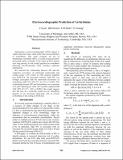Electrocardiographic prediction of arrhythmias
Author(s)
Syed, Z.; Scirica, B. M.; Stultz, Collin M.; Guttag, John V.
DownloadSyed-2009-Electrocardiographic prediction of arrhythmias.pdf (134.8Kb)
PUBLISHER_POLICY
Publisher Policy
Article is made available in accordance with the publisher's policy and may be subject to US copyright law. Please refer to the publisher's site for terms of use.
Alternative title
Computers in Cardiology, 2009
Terms of use
Metadata
Show full item recordAbstract
Information in electrocardiographic (ECG) signals is widely believed to have value in the short-term prediction of arrhythmias. This study evaluates the use of morphologic variability (MV), a recently proposed metric measuring subtle variability in the shape of ECG signals over long periods, to risk stratify patients for arrhythmia following non-ST-elevation acute coronary syndrome (NSTEACS). We assessed the relationship between MV and the composite occurrence of ventricular tachycardia and cardiac pause (150 events) in 2302 patients admitted post-NSTEACS. On univariate analysis, high MV was strongly associated with the short-term occurrence of arrhythmias (HR 2.02; 95% CI 1.42-2.87; p < 0.001). The relationship between MV and arrhythmias was consistent even after adjusting for other risk variables (adjusted HR 2.04; 95% CI 1.37 - 3.03; p < 0.001). Our results suggest that MV may be a clinically useful tool for identifying patients at an increased short-term risk of serious arrhythmias in the setting of NSTEACS.
Date issued
2010-04Department
Massachusetts Institute of Technology. Department of Electrical Engineering and Computer SciencePublisher
Institute of Electrical and Electronics Engineers
Citation
Syed, Z., et al. “Electrocardiographic prediction of arrhythmias.” Computers in Cardiology, 2009. 2009. 565-567. ©2009 IEEE
Version: Final published version
Other identifiers
INSPEC Accession Number: 11229460
ISBN
978-1-4244-7281-9
ISSN
0276-6547